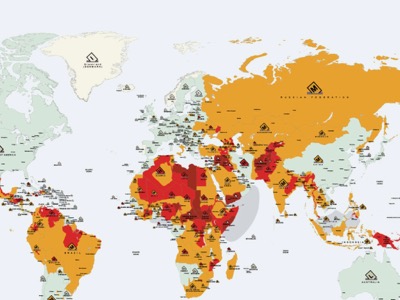
“The Art of War”
Russia and China united against the dollar’s empire
by Manlio Dinucci
http://www.voltairenet.org/article197864.html
We are wrong to think that the armed conflicts occurring across the world
are disconnected one from the other. The reality is that nearly all of them
fall within a broader relationship between “the West’s American Empire”
on the one hand and, the Brics, an organization of states seeking to establish
a countervailing “alternative international order”, on the other.
This power struggle is played out using two power bases that are closely connected:
the military and finance.

There is now a vast arc of tensions and conflicts that extends from Eastern Asia to Central Asia, from the Middle East to Europe, from Africa to Latin America. The “hot points” along this intercontinental arc– the Korean Peninsula, the South China Sea, Afghanistan, Iraq, Iran, Ukraine, Libya, Venezuela and others – have different histories and geopolitical features, but there is a thread that stitches them together: the strategy being deployed by “the American Western empire”, now in decline, to stamp out new states and social subjects before they can rise. The Brics Summit (Brazil, Russia, India, China and South Africa) that took place from 3-5 September 2017, at Xiamen, China, has grasped what Washington’s fear is.
The Russian President, Putin, expressing “the BRIC countries’ concerns over the unfairness of the global financial and economic architecture which does not give due regard to the growing weight of the emerging economies”, stressed the need to “overcome the excessive domination of a limited number of reserve currencies”. This was clearly a reference to the US dollar, which constitutes almost two thirds of the global reserve currencies and the currency which determines the price of petrol, gold and other strategic raw materials.
This permits the U.S. to maintain its dominant position by printing dollars
the value of which is not based on the US’s real economic capacity but
on its use as a global currency. However, three significant events may eclipse
the US’s dominance:
1. a year ago, the Chinese yuan entered into the basket of the IMF’s exchange
currencies, (joining the dollar, the euro, the yen and the sterling).
2. Peking is on the verge of launching contracts in yuan to purchase oil, convertible
to gold.
3. the Brics are asking for the quotas, and thus the votes attributed to each
country within the IMF, to be revised. This is because the US alone, has more
than twice the total number of votes of the 24 countries of Latin America (including
Mexico) and the G7 holds triple the votes of the Bric countries.
Washington is eyeing the Russian – Chinese partnership with growing concern for the following reasons: • the exchange between the two countries is growing rapidly and should reach 80 billion dollars in 2017; • there has been a surge in the number of co-operation agreements between China and Russia in the following sectors: energy, agriculture, aeronautics, space and infrastructure; • it was announced that a Chinese company would purchase 14% of Rosneft (the Russian state oil company) and Russia would supply gas (38 billion m3 yearly) to China through the new gas pipe line, Sila Sibiri, which will become operational in 2019. This will open to the Russian energy export, the path to the East, getting around the U.S.A.’s attempt to block its entrée to the West though Europe.
Since the U.S.A. is losing ground in economic terms, it is throwing on the
balance the full weight of its ace: its military might and political influence.
The U.S.’s military pressure in the South China Sea and in the Korean peninsular,
the U.S./Nato wars in Afghanistan, the Middle East and Africa, the U.S.A./Nato
“push” in Ukraine and the ensuing confrontation with Russia all form
part of one strategy: global confrontation with the Russia/Chinese partnership.
A clash of not only of economic wills but also geopolitical. It also forms part
of the plan to implode the Brics, making the pendulum of political power swing
wildly to the Right in Brazil and the whole of Latin America. Kurt Tidd, is
the Commander of the U.S. Southern Command. He is preparing the military option
that Trump threatened to apply against Venezuela: in a Senate Hearing, he accuses
Russia and China of exerting an “evil influence” in Latin America,
so that they can carry forward into this region “their vision of an alternative
international order”.
Manlio Dinucci
Translation
Anoosha Boralessa
Source
Il Manifesto (Italy)
<:ver_imprimer:> Facebook Twitter Delicious Seenthis Digg RSS
Manlio Dinucci
Manlio Dinucci Geographer and geopolitical scientist. His latest books are
Laboratorio di geografia, Zanichelli 2014 ; Diario di viaggio, Zanichelli 2017
; L’arte della guerra / Annali della strategia Usa/Nato 1990-2016, Zambon
2016.
North Korea in the Great Nuclear Game
North Korea in the Great Nuclear Game
“The Art of War”
The new Nato intelligence headquarter
The new Nato intelligence headquarter
“The Art of War”
Large-scale manoeuvres encircling Venezuela
Large-scale manoeuvres encircling Venezuela
“The Art of War”
This is how the USA “reassures Europe”
This is how the USA “reassures Europe”
“The Art of War”
Now in orbit: the first “Italian” spy satellite
Now in orbit: the first “Italian” spy satellite
This author's articles
To send a message
Voltaire Network
Voltaire, international edition
Focus
News in Brief
Controversies
Diplomatic Wire
D